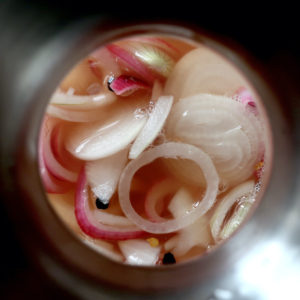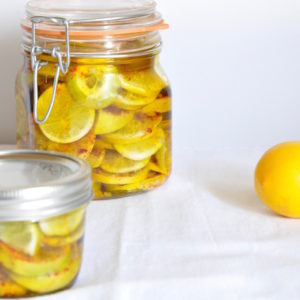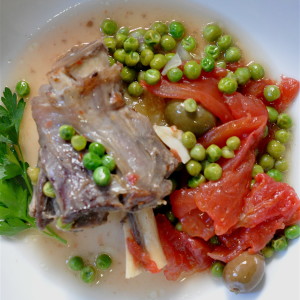Pickled Grapes
As the holidays ramp up, so does the production of foods falling under the capacious, vague, generally alarming category of edibles labeled “great with a cheese platter.” Let’s not even discuss those foods that are “terrific with charcuterie!”

Coming soon to a holiday table near you.
Even the most cheese-loving person can consume limited amounts of this stuff. So it is I’ve avoided pickling fruits, including grapes.

These are raw green olives. Most people cannot access these, so I share as a curiousity (and a way to bulk out a dearth of pickled grape pictures) This is my third attempt at brining olives. The first time the olives remained inedibly bitter. The second time I messed up and the brine spoiled. Here we are at third attempt. It takes six months, so don’t hold your breath.
Returning to pickling grapes. It was a horribly hot afternoon, and I’d picked up the Zuni Cafe Cookbook, searching for another recipe (Fish? Fowl? Last week was a long time ago. An eternity). Instead I found pickled grapes. For once I had all the ingredients in the house– a rare event–and thought, well, what the hell.

Granted, it’s not as if I were embarking on an Ottolenghi recipe.
Into the kitchen.
The original recipe calls for 3/4 cup sugar (175 grams) and allspice. My aversion to sugar is well documented. As for allspice, I find it is like certain politicians: it tends to take over. I reduced the sugar to a scant 1/2 cup (100 grams), and seasoned with cardamom, coriander, fennel seed, and a bay leaf.

Either white wine or Champagne vinegar will work here. Avoid cider or malt vinegars, which are too harsh for this pickle. Look for a vinegar with 5% acidity or higher, ensuring safe long-term keeping.

As for the grapes, Rodgers calls for Zante or another small, seedles grape. I used Thompson, as they were available. Whatever you buy, be sure to purchase a seedless variety, thus ensuring a pleasant eating experience.

In addition to being lovely to look at, pickled grapes are truly good: they have none of the weirdness one encounters with pickled fruits, the “I should like this, but I don’t” feelings (and you know have them), that confused guilt because you are a sophisticated person, somebody who knows how to eat, but deep in your inmost soul really doesn’t know what on earth you’re going to do with a pickled grape.

Except, of course, eat it with a cheese platter.

Am I right?
Pickled grapes manage to rise above all that (isn’t it nice that something does right now, even if it’s just a grape?). Make your pickled grapes now. Hold the jar until the holidays. If you do the turkey thing in November, serve your pickled grapes then, alongside the bird. Or wait until December. Pickled grapes helpfully keep indefinitely. They continue looking gorgeous, which is more than most of us can say.

Pickled Grapes
Adapted from a recipe in The Zuni Cafe Cookbook by Judy Rodgers
Yield: one large jar
Prep time: about 25 minutes
You will need a lidded jar large enough to hold 1 pound/464 grams of grapes to make pickled grapes. A 2 pint/454grams jar is large enough. Please read the notes, below for a discussion of grape and vinegar varieties, along with a brief discussion about safe pickling.
1 pound/454 gram seedless grapes, ideally organic
1 bay leaf
A few whole allspice berries, or a few whole coriander seeds
About 1/4 teaspoon fennel seeds (optional)
A few green cardamom, cracked but left whole (optional)
1/2 cup-3/4 cup (100-175 grams) white sugar
1 cup/227 grams Champagne or white wine vinegar of 5% acidity
1 cup/227 grams dry white wine or Vermouth
Sterilize your jar by either running it through the dishwasher or washing it in hot soapy water. Do not touch the inside of the jar once you’ve sterilized it. Wash the lid, too.
Drop the bay leaf, coriander, and fennel seeds into the jar.
Remove any rotted grapes.
Any grapes that have naturally dried out a bit are safe to use in the pickle.
Wash and dry the grapes well. Break or scissor them apart into clusters. Place in the jar.
Put the sugar, vinegar, and wine in a small, nonreactive pan. Bring to a gentle simmer. Stir with a wooden spoon to help sugar dissolve. Cover the pan and allow to barely simmer for a minute or so.
Taste the brine: it should tart, but not eye-watering. If it’s too tart, or too sweet, adjust accordingly, adding either more sugar or vinegar.
Allow the brine to cool completely. Once it’s cool, pour it over the grapes, put the lid on the jar, and label with name and date.
Refrigerate pickle for one week before eating.
Pickled grapes keep indefinitely. Rodgers advises refrigeration. They could be safely kept in a cool area, but why tempt fate?
Pickled grapes act as a foil to rich dishes like beef or turkey. Rodgers suggests adding a few to a pan of chicken livers just before serving. They would also work well in salads, and yes, as part of cheese board.
Note on safety
Pickled grapes are preserved using vinegar with 5% acetic acid, which ensures long term keeping. Avoid rice vinegars for this recipe. They are delicious, but at 2-3%, too low in acetic acid to ensure long term safe storage.
It is safest to refrigerate your pickled grapes.
Organic or low pesticide grapes are best for this recipe. Search for seedless grapes; you don’t want to be crunching seeds.





